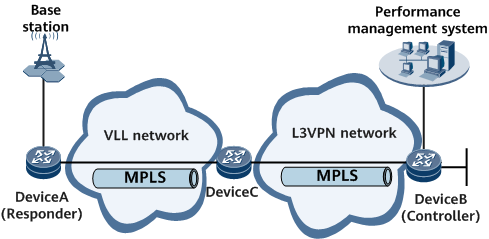TWAMP Light Application on a VLL+L3VPN Network
On a VLL and L3VPN hybrid network as shown in Figure 1, Device A functions as the Responder on a VLL network and is deployed as the last-hop device connected to the base station. Device A responds only to packets received over test sessions. Device B functions as the Controller and is deployed on the aggregation node to send and receive packets over test sessions, collect and calculate performance statistics, and report the statistics to the performance management system.
TWAMP Light is used to obtain E2E service link quality indicators on a VLL+L3VPN network.
- The Control-Client is configured on the Controller, and a TWAMP Light test session is created.
- The test session is configured on the Responder, and packets received from a specified interface are matched against rules.
- The Session-Sender is configured on the Controller to start the test session, and the Controller sends TWAMP-Test packets to the Responder.
